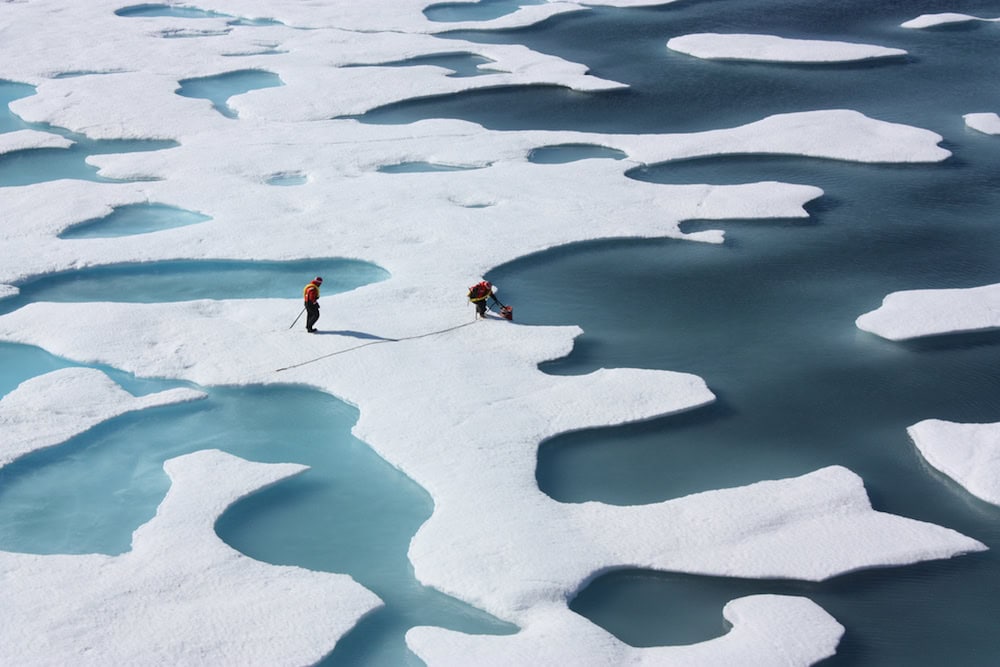
[Image] Arctic sea ice coverage continues to decrease every year. Ice911, a nonprofit group, proposes spreading reflective glass beads on the ice to slow melting. Credit: NASA Goddard
Since 2006, the National Oceanic and Atmospheric Administration (NOAA) Arctic Program has put out an annual Arctic Report Card, which contains information on the current state of the Arctic environmental system relative to historical records. The most recent report card, which came out in December, is troubling.
“In 2018, the [Arctic] sea ice remained younger, thinner, and covered less area than in the past … Near record sea ice minimums have now occurred every year for the past 12 years,” explains a NOAA narrator in a video summarizing the report’s findings.
Decreasing ice coverage contributes to a host of worrisome conditions. For example, less ice provides more area for expanded harmful toxic algal blooms, and less landfast ice means the coast does not have adequate protection from the erosive action of waves.
If the melting of sea ice could be slowed or reversed, that would help slow these other detrimental circumstances as well. Unfortunately, the rate of sea ice loss is projected to accelerate due to a positive feedback loop.
A positive feedback loop refers to a system in which changes are enhanced or amplified; in this case, the rate of sea ice loss continuously increases. Ice reflects more sunlight than dark ocean water, which instead absorbs solar energy and warms, causing ice to melt. The more ice melts and the more water opens to the sun, the faster the warm/melt cycle takes place.
Based on this loop, ice coverage will continue to decrease if left to its own devices. But that’s if sea ice is left to its own devices, a situation that nonprofit group Ice911 intends to change.
In 2006 (the same year as the first Arctic Report Card), chemical and electrical engineer Leslie Field saw the movie “An Inconvenient Truth,” which inspired her to approach climate change as a materials issue. She decided to focus on the issue of melting sea ice and in 2007 began testing different materials to see which could best reflect the sun.
Now, over 10 years later, Field and her Ice911 team members have developed a possible solution, one they are testing on a lake in Barrow, the northernmost town in Alaska.
“The idea is to try to rebuild a natural system with the least possible intervention,” Field says in an interview with HBO. To do so, she and Ice911 members propose a reflective “sand” made of powdered glass microspheres be spread over sea ice.
The powder is mainly silica in the form of hollow glass spheres, with an average diameter of 65 μm (almost five times smaller than the diameter of a period!). It is available commercially in large amounts, and the Ice911 members have published an open-access paper showing results of birds and small fish eating it with no apparent problems.

The Ice911 team propose sprinkling this powdered glass “sand” on sea ice to increase its reflectiveness and slow its melting. Credit: Ned Rozell, University of Alaska Fairbanks
Field and her team member Alex Sholtz recently presented their work at the University of Alaska Fairbanks (UAF) to other scientists who work on northern sea ice. As a UAF article covering the presentation notes, a few Alaskan researchers had doubts about the project’s feasibility.
“Ice911 is doing this for noble reasons, but I sense a disconnect between what pencils out well on paper and how it could be implemented on a practical basis,” UAF oceanographer Seth Danielson says in the UAF article. For example, he points out that using an icebreaker to distribute the beads would decrease the reflectiveness of the pack ice field as the ship broke through, counteracting the purpose of the beads.
Despite these misgivings, Field and other researchers feel these climate intervention, or “geoengineering,” approaches may be the only way to combat the effects of climate change.
“Is this a massive endeavor? Yes,” Field says in the UAF article. “But look at what we’re fighting against.”
The open-access paper on the beads, published in Earth’s Future, is “Increasing Arctic sea ice albedo using localized reversible geoengineering” (DOI: 10.1029/2018EF000820).
Author
Lisa McDonald
CTT Categories
- Environment
- Glass


